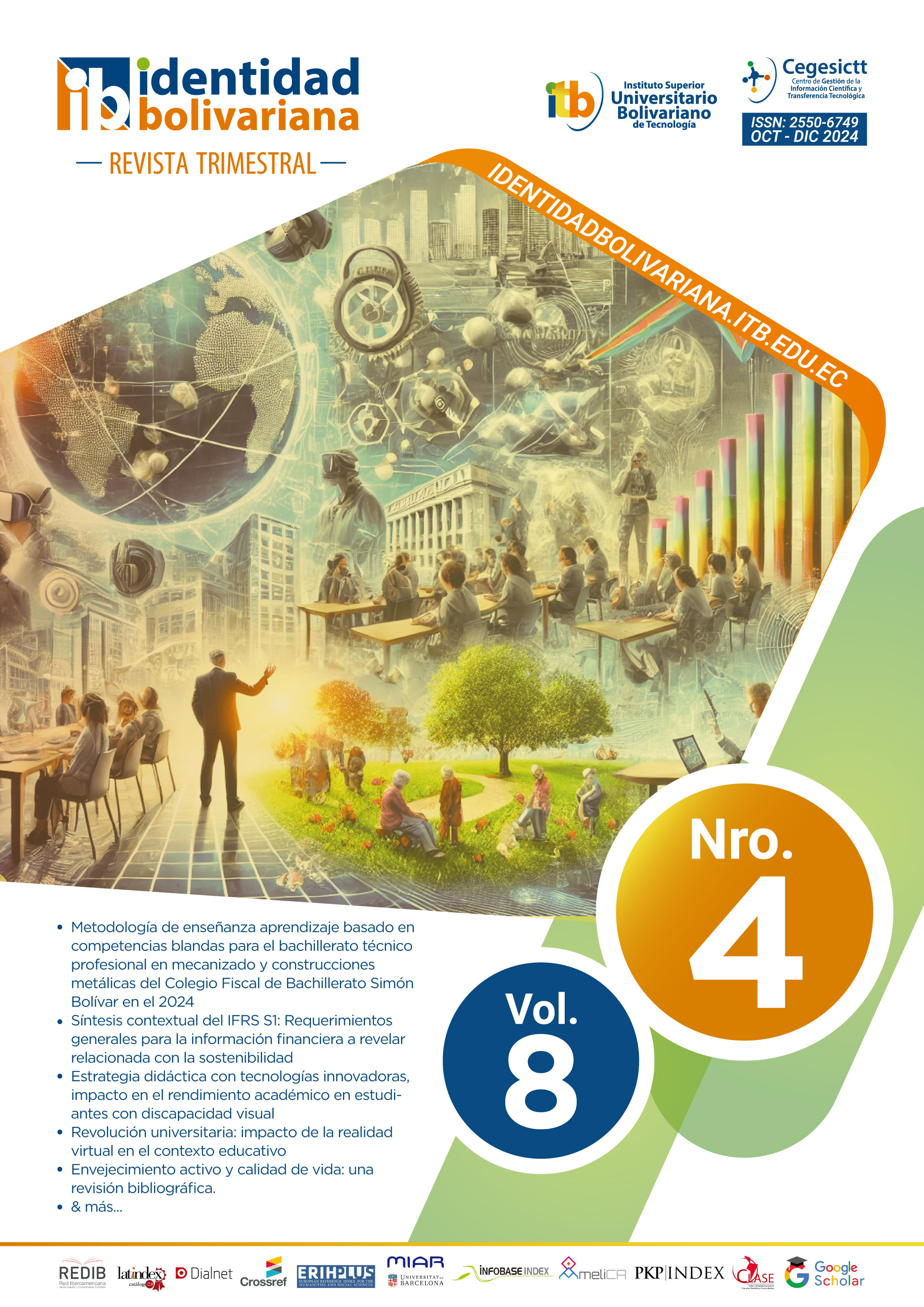Didactic strategy with innovative technologies, impact on academic performance in students with visual disability
Main Article Content
Abstract
The main objective of this study was to propose a teaching strategy, with the integration of technological tools in the teaching-learning process to improve the academic performance of students with visual disabilities at the State University of the South of Manabí. A scientific research methodology was used that included methods at the theoretical, empirical and mathematical statistical level, such as: Historical logic, synthesis analysis, literature review, observation, interview and survey. This is an exploratory study that allows us to analyze issues related to the adaptation of inclusive curricula for students with visual disabilities. This research identifies technological tools for the development of integrated learning with equity and inclusion of underrepresented groups in higher education. The steps and components of the proposal can be developed as alternatives to change educational systems and learning environments and respond to the diversity of students, for which measures were applied in terms of teacher training, available infrastructure, computer equipment, curriculum, communication and personal care. The results show that the use of teaching strategies with the use of technologies contributes to learning in students with limited vision, helping them acquire information, communicative autonomy and the ability to process new digital materials, increasing their academic performance. In this way, higher education favors the creation and development of educational equality and the inclusion of groups with special abilities.
Article Details
Section
How to Cite
References
Arroyo , J. L., & Luque , R. (2018). Estrategias de aprendizaje y rendimiento académico en estudiantes de quinto de secundaria de una institución educativa pública de Huanta. Universidad Ricardo Palma. https://repositorio.urp.edu.pe/bitstream/handle/URP/1926/TESIS%20-%20Arroyo%20Luigi%20%26%20Luque%20Rogger.pdf?sequence=1&isAllowed=y
Basantes, A. (2018). Los Lectores de Pantalla: Herramientas Tecnológicas para la Inclusión Educativa de Personas no Videntes. Información Tecnológica, 29(5), 81-90. https://doi.org/http://dx.doi.org/10.4067/S0718-07642018000500081
Campos , A. K., & Canelo, D. M. (2019). Las barreras que limitan la educación inclusiva y su relación con el rendimiento academico de los estudiantes con discapacidad de la Universidad Nacional de San Agustin Arequipa - 2018. Arequipa-Peru: Universidad Nacional de San Agustin Arequipa. http://repositorio.unsa.edu.pe/bitstream/handle/UNSA/9395/TScalaak.pdf?sequence=1&isAllowed=y
Delgado-, J. C., Valarezo, J. W., & Acosta, M. T. (2021). Educación Inclusiva y TIC: Tecnologías de Apoyo para Personas con Discapacidad Sensorial. Revista internacional tecnologica educativa docentes 2.0, 11(1), 1-8. https://doi.org/https://doi.org/10.37843/rted.v11i1.204
Góngora Morgado, L., & Góngora Reyes, Y. (2023). Actividades didácticas interactivas, una motivación para el aprendizaje en la asignatura matemática . Journal TechInnovation, 2(1), 13–18. https://doi.org/10.47230/Journal.TechInnovation.v2.n1.2023.13-18
Pastor, R. P. (2019). Herramientas didácticas orientadas al estudiante y el rendimiento académico . Universidad Peruana Cayetano Heredia . https://repositorio.upch.edu.pe/bitstream/handle/20.500.12866/7310/Herramientas_PastorArmendariz_Roberto.pdf?sequence=1&isAllowed=y
Romero, J. X. (2017). Estrategias Didacticas tecnologicas en el rendimiento academico en los estudiantes con discapacidad. Universidad Laica Eloy Alfaro de Manabí Extension Chone.
Maldonado Zuñiga, K., Caicedo Plúa, C. R., Yanina Holanda, C. P., & Leonardo Raul, M. Q. (2023). Las tecnologías y su aplicación en el proceso educativo en la Universidad Estatal del Sur de Manabí. Serie Científica de la Universidad de las Ciencias Informáticas, 16(3), 22-35. Recuperado a partir de https://publicaciones.uci.cu/index.php/serie/article/view/1314
Mera Macías, D. A., & Maldonado Zuñiga, K. (2022). Las Tecnologías de la Información en la enseñanza aprendizaje para una Educación Inclusiva. Revista Científica Arbitrada Multidisciplinaria PENTACIENCIAS, 4(6), 190–203. Recuperado a partir de https://www.editorialalema.org/index.php/pentaciencias/article/view/346
Morán Lozano, N. S., Peñafiel Loor, J. F., & García Rodríguez, R. (2023). Aprendizaje significativo en matemáticas con el uso de tecnologías. Journal TechInnovation, 2(2), 60–69. https://doi.org/10.47230/Journal.TechInnovation.v2.n2.2023.60-69
Vera Velázquez, R., & Valdés Tamayo, P. (2022). Uso de recursos tecnológicos en la enseñanza de las matemáticas. Journal TechInnovation, 1(1), 29–45. https://doi.org/10.47230/Journal.TechInnovation.v1.n1.2022.29-45

